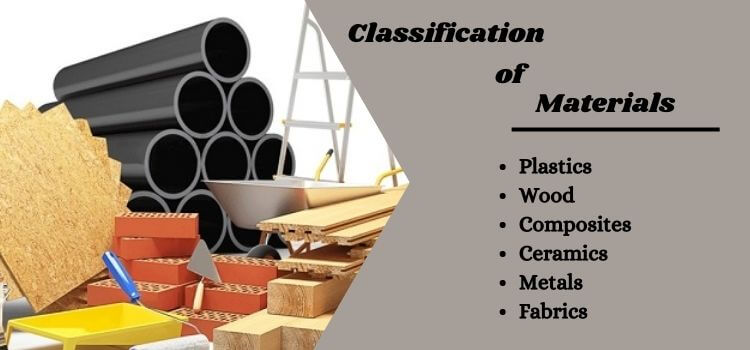Materials are everywhere around us. They are the building blocks of every object that we use in our daily lives, from the clothes we wear and the food we eat to the electronic devices we use for communication. As a result, the study of these materials is of great significance, and it is critical to understand their properties and characteristics to utilize them effectively. In this regard, the classification of materials is essential in identifying their properties and categorizing them based on their characteristics. The classification of materials is a fundamental concept in material science and engineering, and it is an essential tool for scientists and researchers to identify the physical and chemical properties of materials for various purposes. This classification system is based on the inherent properties of different materials and can be used to identify the appropriate material for a specific application.

The Importance of Classifying Materials Correctly
As a fundamental aspect of material science, the classification of materials plays a critical role in understanding the properties and behavior of different substances. Properly sorting materials based on their specific characteristics is essential for engineers, scientists, and manufacturers to select materials effectively for specific applications. Accurate classification enables these professionals to identify the properties and characteristics of each material, such as its chemical composition and structural properties.
Misclassification of material can lead to costly errors and poor product performance. Thus, identifying and categorizing materials correctly is of utmost importance in areas such as manufacturing, engineering, research, and development.
Types of Materials and Their Sub-Classifications
The classification of materials is an essential aspect of materials science. In fact, it is one of the fundamental pillars of the field. Materials can be defined as any substance that is used to make or create something and can exist in various forms, such as solids, liquids, and gases. The classification of materials is based on different criteria, such as physical, chemical, and mechanical properties.
One of the most basic ways of classifying materials is based on their composition. Materials can be classified into metals, polymers, ceramics, and composites, among others. Each of these categories has its own unique properties, which make them suitable for specific applications. Furthermore, materials can be sub-classified based on their specific properties and applications, such as ferrous and non-ferrous metals or thermoplastic and thermosetting polymers. Understanding the classification of materials and their sub-classifications is crucial in order to predict their behavior and properties and to design and develop new materials with improved performance.
Advantages and Disadvantages of Classifying Materials
Classification is a fundamental aspect of modern science that enables scientists to organize materials into categories based on their physical and chemical properties. Through this process, we can make meaningful comparisons between substances, predicting their behavior and applications. However, the classification of materials comes with both advantages and disadvantages. On the one hand, classifying materials allows for a systematic study and identification of the properties and behavior of specific materials.
Here are some of the advantages of classifying materials:
- It provides a way for scientists to make meaningful comparisons between various substances and their properties.
- It enables engineers to select appropriate materials for specific applications.
- It allows for the identification of new materials with improved performance.
- It helps manufacturers identify the best material for a given application.
This creates a more precise understanding of how materials function in different environments and processes. On the other hand, misclassification of material can lead to erroneous analyses and conclusions, which can lead to significant mistakes in research and development. Additionally, classifying materials can lead to oversimplification, leading to less nuanced understandings of complex phenomena. Here are some of the disadvantages of classifying materials:
- It can lead to oversimplification and inaccurate analysis.
- It can cause confusion due to the misclassification of materials.
- It can make it difficult to identify new properties or behaviors in a material.
- It can limit our understanding of complex material phenomena.
It is important to understand the advantages and disadvantages of classifying materials so that we can make informed decisions when dealing with various types of materials. Classifying materials correctly can result in a greater understanding of their properties and behavior, which can lead to improved product performance, safety, and efficiency.
Common Applications of Materials Classification
Materials classification is an important tool for scientists, engineers, and manufacturers alike. It enables them to identify the specific properties of a material, such as its chemical composition and structural characteristics. This information can then be used to make informed decisions about the selection of materials for different applications. Some common applications of materials classification include:
- Designing and developing new materials with better performance.
- Assessing the suitability of a material for certain applications.
- Comparing different materials to identify which one is best suited for a particular application or process.
- Analyzing the behavior of a material in different environments or processes.
- Investigating the relationship between a material’s properties and its behavior.
- Identifying materials that can be recycled or reused for different purposes.
How Classification Helps in Selecting the Right Material
Classifying materials helps to identify their various properties and characteristics, enabling engineers and designers to make better-informed decisions about the selection of materials for specific applications. By understanding a material’s physical, chemical, and mechanical properties, it is possible to select the most appropriate material for a particular application or process. This is especially important in industries such as aerospace, automotive and medical, where the selection of materials can have significant implications for performance, reliability, and cost. With a comprehensive understanding of materials classification, it is possible to identify the most suitable material for any given application or process.
In Conclusion
Understanding the classification of materials is important in engineering and manufacturing to ensure that the right materials are chosen for specific applications. The different categories of materials have unique properties that make them suitable for specific uses, such as strength, flexibility, conductivity, and durability. By learning about these categories and their characteristics, engineers and manufacturers can select the best materials to meet their needs and create high-quality products. It’s important to continue educating ourselves on the classification of materials as technology advances and new materials are developed.






Leave a Reply